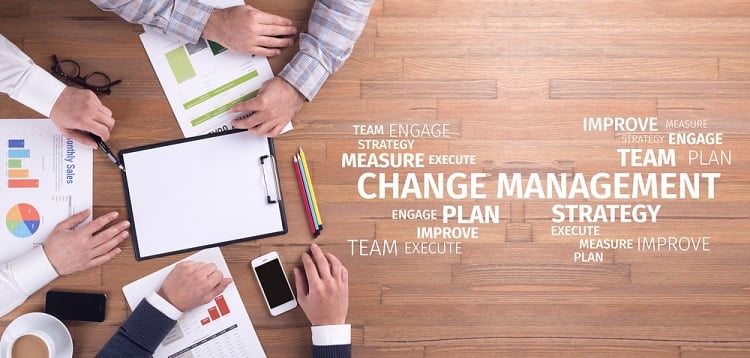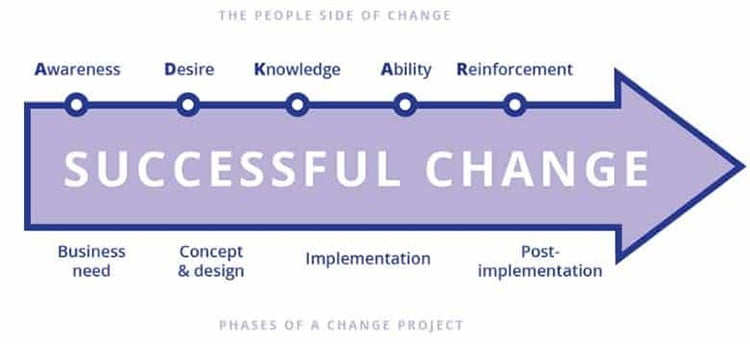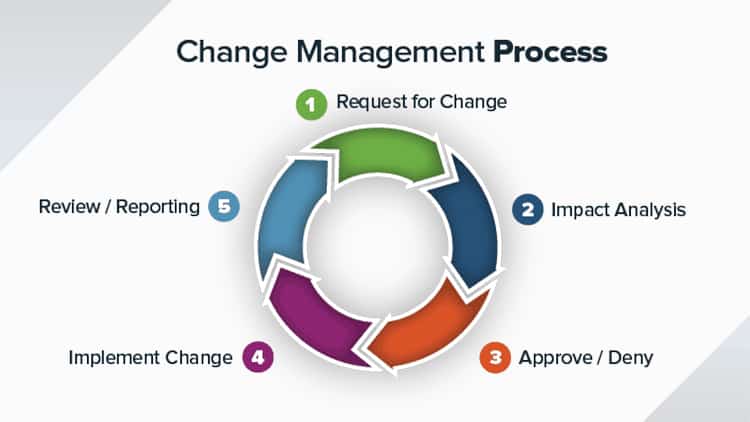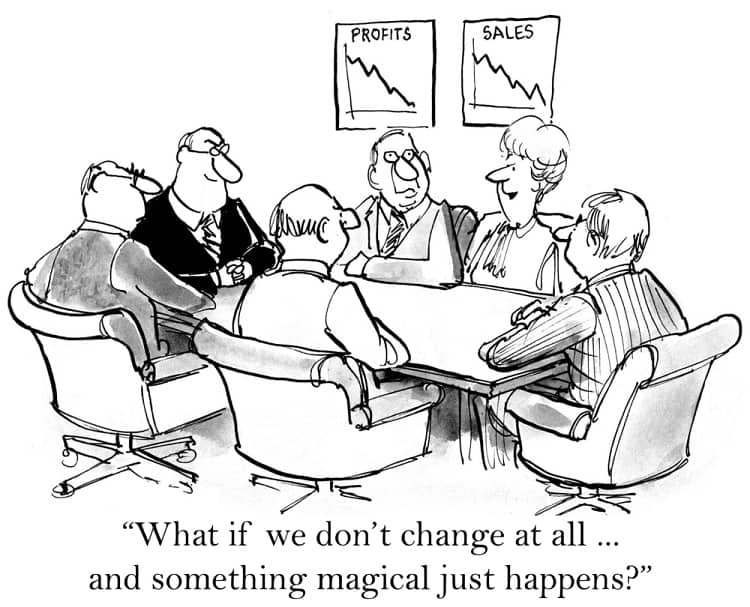
Home » Insights & Research » Change Management: Best Practices for Leading Organizational Transformation
Change is inevitable in today’s dynamic business environment. Whether it’s implementing new projects to enhance performance, seizing emerging opportunities, addressing organizational shortcomings, or adapting to market fluctuations, change touches every aspect of an organization – from processes and job roles to technology and structure. However, the cornerstone of successful transformation lies in altering how employees work. If they are resistant to change or unable to adapt to new ways of working, even the most well-conceived initiatives are doomed to fail. As a leader or manager, your pivotal role is to spearhead effective change management strategies, ensuring the successful realization of strategic initiatives and helping your business achieve its desired outcomes.
Quick links
What is Change Management?
Change management is a systematic approach employed by organizations to prepare, plan, and support individuals through a period of transition. Its ultimate objective is to drive success and enhance business outcomes – by ensuring that changes are effectively implemented and adopted.
While each organization and change initiative has its distinct characteristics, decades of research have identified key strategies that businesses can employ to facilitate and influence personal transformation among their employees.

History of Change Management Theory
The origins of change management theory can be traced back to the mid-20th century, beginning with Kurt Lewin’s influential Three-Step Model of Change in the 1940s. This foundational theory was further developed with Everett Rogers’ seminal work, “Diffusion of Innovations,” published in 1962, and William Bridges’ Transition Model introduced in 1979. However, it wasn’t until the 1990s that change management truly gained prominence as a significant topic within the business landscape.
Back in the day, the process of designing, developing, testing, and deploying new products, technologies, or ideas often spanned several years. Nowadays, technological advancements and agile methodologies have shortened it to mere months or even weeks. Additionally, the escalating consumer demand for superior, faster, and more affordable products has necessitated a shift in organizational culture, prompting businesses to adapt and evolve more swiftly than ever before.

3 Levels of Change Management
Change management operates across three distinct levels:
Personal
Resistance to change is a natural human response, stemming from both physiological and psychological factors. However, with proper support and guidance, one may become better equipped to adapt and thrive amidst change.
At the personal level, effective change management requires leaders and managers to comprehend the individual transformation process and identify the essential catalysts for change. Key considerations for leaders include:
- Determining the critical messages employees need to hear, their timing, and the appropriate source.
- Identifying the optimal timing for training employees in new skills.
- Providing coaching and mentorship to facilitate behavioral change.
- etc.
Organizational
Leading change at the organizational level is integral to successful project management. This involves identifying the specific individuals or teams requiring change to achieve desired business outcomes and determining the best approaches to facilitate this.
Organizations must develop comprehensive plans to foster awareness, enhance leadership capabilities, and provide necessary coaching and training to support employees throughout the process.
Enterprise
At the enterprise level, the focus is on driving competitive advantage by refining organizational roles, structures, processes, projects, and leadership capabilities. The ultimate objective is to enable individuals to adapt to change more efficiently, empower businesses to respond swiftly to market shifts, embrace strategic initiatives, and swiftly integrate new technologies.

Prosci’s change management maturity model
(Source: prosci.com)
Change Management Models
The evolution of change management theory has given rise to numerous models, each developed through rigorous research and practical experience in both business and personal contexts. These offer structured frameworks that organizations may utilize to navigate the complexities of change effectively.
Here is a curated collection of influential models, methodologies, and templates that provide a comprehensive overview of effective approaches to managing change. This compilation includes renowned theories such as McKinsey’s Change Management Framework, John Kotter’s Change Management Model, ADKAR, and the Deming Model.

Kotter’s Chanfe model
(Source: kotterinternational.com)

ADKAR model
(Source: prosci.com)

Deming model
(Source: wikipedia.org)
Change Management Process
From a procedural standpoint, change management encompasses a series of steps that guide individuals or teams through a particular project or initiative. It entails devising a strategy and plan aimed at navigating the team through periods of flux. The process typically consists of three primary stages:
Design
- Define the need for change: This involves identifying the driving forces behind the change and the expected benefits. What problem are you trying to solve, or what opportunity are you trying to capture?
- Set SMART goals: SMART stands for Specific, Measurable, Achievable, Relevant, and Time-bound. Clearly define what success looks like for this change initiative. How will you measure progress and know when you’ve reached your goals?
- Develop a plan: This plan outlines the strategies and tactics for implementing the change. It should include:
- Communication strategy: How will you communicate the change to all stakeholders? What are the key messages?
- Stakeholder analysis: Who will be impacted by the change? How will you address their concerns and gain their buy-in?
- Training and development: What training is needed to ensure everyone has the skills and knowledge to work effectively under the new way of doing things?
- Risk management: Identify potential risks and develop mitigation strategies.
Implement
- Launch the change: The next phase is where you put your plan into action. This may involve piloting the change with a small group first, depending on the scale and complexity of the initiative.
- Communication and activities: Keep everyone informed throughout the process. Address concerns, provide ongoing support, and celebrate successes along the way.
- Monitor and adapt: Track progress towards your goals and be prepared to make adjustments to the plan as needed.
Sustain
- Reinforcement and recognition: Embed the change into the organizational culture by reinforcing the desired behaviors and recognizing those who are championing the new way of working.
- Continuous improvement: Change is rarely a one-time event. Look for ways to continually improve the new process or system.

For leaders in senior positions, their role in change management initiatives is not merely advocating for transformation; it’s about demonstrating commitment to change – both personally and organizationally. Leaders are expected to act as coaches who provide guidance and support to their teams throughout the transformation journey. This forms the foundation for organizations to operate more efficiently and successfully, particularly in today’s volatile, uncertain, complex, and ambiguous (VUCA) environment.
Change management transcends mere communication and training. It’s about adhering to a structured process while employing a comprehensive toolkit to drive successful organizational and individual change.
The Importance of Change Management
In today’s volatile business landscape, the significance of investing in change management strategies cannot be overstated, whether at the micro or macro levels. Here are three compelling reasons that underscore its importance:
Organizational change begins with individuals
Businesses don’t change, only people change.
While it may be tempting to view change solely from an organizational lens – focusing on aspects like financial structures, system integration, or office locations, especially during mergers or acquisitions – it’s crucial to recognize that organizational change is fundamentally driven by individual transformations. Each member’s adaptability and willingness to embrace change lay the groundwork for successful transformation. Without everyone adapting their daily routines and work practices, even the most well-intentioned business transformation efforts are likely to fall short of producing meaningful results.

Cost-effective approach
Organizations that overlook the human elements typically faces several detrimental consequences, including:
- Widespread productivity declines
- Reluctance from management to allocate necessary time or resources for change
- Key stakeholders being absent from crucial meetings
- Disruptions in business operations noticed by suppliers and customers
- Decreased employee morale and increased internal divisions
- Elevated levels of stress, confusion, and fatigue
- High employee turnover rates
- Projects running behind schedule, exceeding budgets, or even being abandoned
- etc.
Fortunately, these adverse outcomes can be mitigated through a structured change management approach that prioritizes people.

Enhanced business success rates
Empirical evidence underscores the profound impact of effective change management on business success. According to Prosci’s research, organizations with excellent change practices saw 93% of their leaders meet or exceed their objectives. In contrast, only 15% of organizations with poor change practices achieved their goals. In essence, implementing a robust change management strategy can amplify a business’s chances of success by up to sixfold.


Examples of Situations That Require Change Management
- Adopting new technology: Implementing new technologies often requires employees to adapt to new tools and processes. Effective change management ensures a smooth transition, minimizes disruptions, and maximizes the benefits of technological advancements.
- Mergers & acquisitions: Mergers and acquisitions bring about significant disruptions related to cultures, systems, and processes. Change management is essential to navigate these transitions successfully and ensure alignment between the merging entities.
- Leadership transitions: Whether it’s a change in personnel or leadership style, transitions at the top can have profound effects on organizational dynamics. Change management helps in facilitating smooth leadership transitions and maintaining organizational stability.
- Corporate culture transformation: Shifting or evolving an organization’s culture requires careful planning and execution. Businesses need a framework to drive cultural changes effectively, ensuring alignment with organizational values and objectives.
- Crisis management: During times of crisis, such as economic downturns, natural disasters, or global pandemics, organizations often need to adapt rapidly to emerging circumstances. As such, they need strategies to respond agilely, mitigate risks, and maintain operational continuity.
Challenges of Change Management
Implementing change in the workplace is inherently challenging, and in today’s fast-paced business environment, the pressure to adapt quickly has intensified. According to McKinsey’s research on business transformation efforts, the failure rate stands at nearly 70%. Recent economic downturns have further compounded the complexities of leading change in organizations.

Resistance to change is a natural human response. Disruptions to personal expectations can induce discomfort, even when the changes are positive, such as marriage or parenthood. Here are some common reasons behind such a reaction and their implications:
- Lack of capability: Employees may lack the necessary skills or knowledge to adapt to new changes. Fear of the unknown may hinder participation in training programs – while concerns about not understanding new systems or being overshadowed by more proficient colleagues will just further exacerbate resistance.
- Lack of trust: A deficit of trust results in skepticism towards change initiatives. Employees may fail to see the benefits of the new processes or perceive change as too challenging or risky. There may also be fears that their contributions will be devalued in the new setup.
- Change fatigue: Constant change demands significant mental and emotional energy. The feeling of exhaustion from continuously adapting – similar to navigating multiple languages while traveling – may give rise to a phenomenon named “change fatigue”. Overexposure to frequent system changes, reorganizations, or mergers can diminish employees’ enthusiasm for further upheavals.
- Personal challenges: Personal issues, such as nearing retirement, going through a divorce, or dealing with serious illness, may also cause people to become resistant to change. While they may understand the rationale behind the change intellectually, emotional acceptance may prove to be challenging. In such situations, compassionate leadership that understands and supports employees’ personal challenges is crucial to fostering a positive change environment.
Resistance to change should not be viewed as an indication of disloyalty or incompetence. An effective strategy should encourage open dialogue, allow all stakeholders to voice their concerns, and ensure that change is not imposed but collaboratively embraced.

10 Tips for Effective Change Management
Address change resistance
Any significant transformation inevitably introduces “people challenges.” As new leaders assume roles, job responsibilities evolve, and new skills become essential, employees may experience feelings of insecurity and resistance. Addressing these concerns reactively rather than proactively can adversely impact the pace, morale, and overall outcomes of the initiative.
To effectively manage change resistance, organizations must adopt a structured approach. This begins with the senior leadership team and extends to engaging key stakeholders and leaders throughout the organization. Early development of this approach, coupled with regular adjustments as needed, is crucial for success. This necessitates a continuous cycle of information gathering, analysis, planning, and strategic redesign to ensure alignment with evolving organizational needs and objectives.
Start from the top level
When faced with the inevitability of change, all eyes naturally turn to the CEO and the leadership team for guidance, support, and decisive action. Leadership must not only embrace new approaches but also inspire and motivate employees through the transformation journey. They serve as role models, embodying the desired corporate behavior and setting the tone for the entire organization.
Collaborative synergy within the executive team forms a critical foundation for organizational success.
Example:
Imagine a large retail chain facing a decline in foot traffic due to the rise of online shopping. The CEO recognizes the need for change and announces a major digital transformation initiative, focusing on revamping the e-commerce platform and strengthening the omnichannel experience (blending online and physical shopping).
Initially, excitement is high. However, the leadership team quickly throws itself into implementing technical changes without addressing employee concerns. Sales staff worry about job security and lack the training or support to effectively navigate the new online systems. This leads to confusion, frustration, and ultimately, a decline in customer service quality. Sales figures continue to drop despite the new technology.
Recognizing this misstep, the leadership team shifts its focus. They hold town hall meetings to explain the vision and rationale behind the changes – as well as invest in employee training and create a culture of open communication. Leaders spend time on the shop floor, working alongside employees to understand and address their concerns. This fosters a sense of ownership and collaboration. Gradually, staff become comfortable with the new systems and embrace the omnichannel approach. They can now better assist customers who want to browse online and pick up in-store, or vice versa. Sales figures begin to climb as a result.

Read more: 12 Golden Leadership Principles for Attaining Excellence
Set expectations for all tiers
As transformation initiatives evolve from defining strategies and setting goals to designing and implementing changes, they impact every tier of the organization. A comprehensive change management effort should involve planning for leaders at all levels, cascading responsibility for design and execution throughout the organizational hierarchy to create a cohesive flow across the enterprise. Each organizational layer should have leaders who are not only aligned with the company’s vision but also equipped with the skills, knowledge, and motivation to drive change effectively.
Example:
A large automobile manufacturer needs to streamline its production process to meet growing demand for electric vehicles (EVs). A top-down approach wouldn’t be enough.
The company implements a layered leadership approach to achieve successful change.
- Top Layer (Executives): The executive team defines the strategic vision for the shift towards EV production, focusing on efficiency, sustainability, and market competitiveness.
- Middle Layer (Managers & Engineers): Senior managers and engineers translate this vision into actionable plans. They identify specific areas for process improvement, design new production lines for EVs, and select necessary technology.
- Frontline Layer (Team Leaders & Workers): Team leaders and production workers are actively engaged in the change process. They receive training on the new EV technology, participate in pilot programs for streamlined processes, and provide valuable feedback on implementation challenges.
By involving each layer of leadership, the company benefits from diverse perspectives and expertise. Team leaders and workers, closest to the actual production line, can identify potential bottlenecks and suggest effective solutions. This collaborative approach fosters ownership and buy-in at all levels, leading to a smoother transition to EV production. With everyone aligned and empowered, the company achieves its goals of increased efficiency and successful EV launch.
Formalize the change
Logical employees often question the extent of change required, the direction in which the company is heading, and their willingness to embrace change. Formalizing change through a written vision statement is a pivotal step in aligning leadership and teams. This process can be structured in the following three steps:
- Acknowledge reality: Clearly articulate the need for change, providing compelling reasons that resonate with employees.
- Inspire confidence: Express unwavering faith in the company’s future and the leadership’s role in guiding the organization through change.
- Provide clear guidance: Offer detailed instructions on expected behaviors and decision-making processes.
Leadership should customize this message for different internal audiences, presenting the impending change in a context that resonates with each group. Regular team coaching sessions may further facilitate open communication and foster alignment around shared objectives.
Example:
A large hospital system is facing increasing pressure to reduce costs while maintaining high-quality patient care. Leaders recognize the need for change and understand that a clear vision statement is crucial for employee buy-in.
They utilize a formalized, three-step approach:
- Acknowledge reality: The vision statement openly acknowledges the challenges of rising costs and the need for operational efficiency.
- Inspire confidence: It emphasizes the hospital’s unwavering commitment to patient care and highlights future investments in cutting-edge technology and staff development.
- Provide clear guidance: The vision outlines specific areas for improvement, such as streamlining administrative processes and exploring cost-effective treatment options, while ensuring these changes prioritize patient well-being.
However, the hospital leadership goes beyond a single document. They customize the message for different departments. For example, doctors receive a vision statement that emphasizes continued investment in medical equipment and research opportunities. Nurses are presented with a vision that focuses on streamlining administrative tasks to free up more time for direct patient interaction.
Regular town hall meetings and Q&A sessions further facilitate open communication and address employee concerns. This multi-pronged approach fosters a sense of shared responsibility and empowers staff to contribute to achieving the defined goals. The clear vision statement, combined with ongoing communication, helps navigate the change process while maintaining staff morale and ensuring continued high-quality patient care.

Establish ownership
Effective change management demands that leadership proactively engage in motivating employees to embrace the new direction. Managers must be prepared to take ownership and ensure that the change is implemented across all areas under their purview.
Ownership can be fostered by cultivating a participative environment where employees are encouraged to identify challenges and contribute to solutions. This engagement can be reinforced through tangible incentives, such as bonuses, or intangible rewards, like fostering strong interpersonal relationships and a shared sense of purpose.
Example:
A software development company is planning a major upgrade to its core product. They recognize the importance of employee buy-in for a successful launch.
To foster ownership, leadership implements a two-pronged approach:
- Participative environment: Developers are actively involved in the process. They participate in workshops and brainstorming sessions, identifying potential challenges with the new system and suggesting solutions. This allows them to feel a sense of influence and control over the direction of the upgrade.
- Tangible & intangible rewards: Leadership acknowledges employee contributions through various means. Developers who provide valuable solutions receive bonuses or recognition programs. Additionally, the company fosters a sense of shared purpose by emphasizing how the upgrade will improve user experience and solidify the company’s position in the market. This creates a sense of accomplishment and motivates employees to go the extra mile for a successful launch.
By encouraging participation and acknowledging contributions, leadership empowers employees and fosters a sense of ownership. This leads to a more engaged workforce, better prepared to navigate the change, and contribute to a smooth product upgrade.

Communicate clearly
Leaders often fall into the trap of assuming that everyone shares their understanding of the problem, recognizes the need for change, and perceives the new direction as clearly as they do. An effective change management strategy necessitates reinforcing the core message through consistent and timely communication.
Communication should flow in both directions – upward from leaders to employees, and downward from employees to leaders – to ensure information dissemination, gather feedback, and encourage employee contributions.
Example:
In the late 1990s, Charles O. Rossotti, the Commissioner of the Internal Revenue Service (IRS), recognized an opportunity to redefine the agency’s relationship with taxpayers. He envisioned transforming the IRS from a bureaucratic entity into a world-class service organization. Rather than merely redesigning systems and processes, Rossotti urged the IRS’s more than 100,000 employees to adopt a different mindset and approach.
To support this transformative change, the IRS leadership implemented a comprehensive multi-channel communication strategy. This strategy included daily voicemails from commissioners and senior staff, training sessions, videos, newsletters, and town hall meetings. The emphasis on timely, continuous, and robust communication played a pivotal role in elevating the IRS’s customer satisfaction ratings from being among the lowest to surpassing those of renowned companies like McDonald’s and several major airlines in the United States.
Assess corporate culture
Effective change management necessitates a thorough understanding of the cultural and behavioral dynamics at every organizational level. Conducting a culture assessment can provide invaluable insights into an organization’s readiness for change, reveal existing gaps that require attention, and highlight internal conflicts and other significant influencing factors. This assessment process aids in identifying the core values, beliefs, behaviors, and perceptions essential for successfully navigating and implementing change.
Promote transparency
Culture plays a pivotal role in any change management initiative. Clearly defining the existing culture and behaviors serves as the bedrock for embracing new business practices and serves as a model for recognizing and rewarding desired behaviors.
Example:
A large environmental non-profit organization traditionally focused on raising awareness through public campaigns. However, they realized the need for a more data-driven approach to maximize their impact.
Understanding that culture is key, they take a two-step approach:
- Defining existing culture: Leadership openly acknowledges the current culture of passionate activism but recognizes the limitations of solely relying on awareness campaigns. They hold workshops and discussions to ensure everyone understands the need for change.
- Modeling new behaviors: The organization starts by integrating data analysis into existing campaigns. They highlight success stories where data insights led to more effective fundraising or targeted outreach. Additionally, leadership rewards employees who champion data-driven strategies, showcasing this behavior as desirable within the new cultural framework.
By openly discussing the need for change and celebrating successes in the new approach, the non-profit fosters a more data-centric culture. Employees become comfortable with the new approach and see its value in achieving the organization’s mission. This cultural shift allows the non-profit to seamlessly integrate data analysis into their work and maximize their environmental impact.

Be prepared for the unexpected
Transformation strategies rarely unfold exactly as planned. Effective change management requires leadership to continually evaluate the strategy’s effectiveness and the organization’s readiness and adaptability to navigate evolving challenges.
Example:
A large retail bank embarks on a digital transformation initiative to improve customer experience and compete with online fintech companies. They develop a comprehensive strategy to roll out new mobile banking features and streamline in-branch services.
However, during implementation, leadership recognizes the need for continuous evaluation:
- Monitoring progress: They closely monitor customer adoption rates of the new mobile features and gather feedback through surveys and focus groups. This reveals that some features are underutilized, while others require further refinement.
- Adapting strategy: Based on this feedback, leadership adjusts the strategy. They prioritize enhancements to the most popular features and may even remove underutilized ones. Additionally, they may extend training programs for in-branch staff to ensure a smooth customer experience when using the new technology.
By continually evaluating the effectiveness of the changes and adapting the strategy as needed, the bank demonstrates its commitment to a successful transformation. This flexibility allows them to address unforeseen challenges and ensures the new digital tools are well-received by customers.
Adopt a personalized approach
Change impacts both the organization as a whole and each individual within it. Given the significant amount of time employees spend at work, where colleagues often become like a second family, it’s crucial for everyone to understand how their roles will evolve, what to expect during and after the change initiative, how performance will be assessed, and the implications of success or failure for both them and their peers.
Therefore, department managers should strive for honesty and clarity in their communications. Employees will react to the information and attitudes around them, underscoring the importance of their active involvement in the change process. Implementing a transparent reward and recognition system (e.g., promotions, accolades, commissions) can foster motivation and encourage buy-in for the change.
Managing Stakeholder’s Expectations in Change Management
Effective stakeholder management is crucial for the success of any change initiative. Here’s a breakdown of key strategies to manage stakeholder expectations during change management:
- Identify stakeholders: Start by pinpointing everyone who will be affected by the change or who can influence its outcome. This can include employees, managers, customers, partners, and even regulators.
- Understand needs and expectations: Once you’ve identified your stakeholders, delve into their needs and expectations for the change. This can be done through surveys, interviews, or focus groups.
- Develop a plan: Create a plan outlining how you will engage with each stakeholder group. It should include the communication channels you’ll use, the frequency of communication, and the key messages you want to convey.
- Set realistic expectations: Be transparent about the scope, timeline, and potential challenges of the change. Don’t overpromise what can’t be delivered.
- Open communication: Establish clear and consistent communication channels. Regularly update stakeholders on progress, address concerns promptly, and be open to feedback.
Additional tips:
- Use data and visuals: Back up your communication with data and visuals like charts and graphs to make information clear and understandable.
- Schedule regular check-ins: Hold meetings or town halls to keep stakeholders informed and answer questions.
- Track sentiment: Monitor stakeholder sentiment throughout the change process to identify any emerging concerns.
- Be flexible: Be prepared to adapt your approach based on stakeholder feedback and changing circumstances.
Overcoming Change Resistance – Change Readiness Diagnostics
To successfully navigate change initiatives, diagnosing the root causes of resistance is crucial. Change Readiness Diagnostics are tools and assessments used to evaluate an organization’s or individual’s preparedness for a specific change. They provide insights into potential roadblocks and areas where support might be needed.
Benefits:
- Identify sources of resistance: By pinpointing the reasons behind resistance (e.g., fear of the unknown, lack of trust in leadership, or perceived workload increase), you can develop targeted strategies to address them.
- Tailored change management: Diagnostics help tailor your approach to the specific needs and concerns of different stakeholder groups.
- Increased adoption rates: Proactive mitigation of resistance can lead to smoother change implementation and higher adoption rates.
Common diagnostic tools:
- Surveys: Questionnaires can gauge employee sentiment, understanding of the change, and level of comfort.
- Focus groups: In-depth discussions are crucial to uncover underlying concerns and provide a platform for open communication.
- Interviews: One-on-one conversations allow for a deeper understanding of individual perspectives and anxieties.
- Data analysis: Existing data on performance, communication channels, and past change initiatives can provide valuable insights.
Diagnostics should assess factors like:
- Individual readiness: This includes factors like employees’ past experiences with change, their comfort level with ambiguity, and their trust in leadership.
- Task readiness: Whether employees have the necessary skills and knowledge to navigate the change effectively.
- Process readiness: Evaluation of the effectiveness of communication channels, training programs, and support systems related to the change.
Final Thoughts
Change is an inevitable aspect of organizational growth and adaptability in today’s dynamic business landscape. Effective change management is not merely about implementing new processes or systems; it’s about understanding and addressing the human elements that drive these transformations. By adopting a holistic approach that encompasses clear communication, leadership alignment, cultural assessment, and personalized engagement, organizations may become better equipped to navigate disruption, thrive amidst uncertainty, and drive sustainable success.
Other resources you may be interested in:
- Human Leadership in a Digital World: A How-to Guide
- Transformational Leadership: Inspiring Change & Growth
- HR Transformation: Future-Proof People Strategy
- Business Process Transformation: Strategies for Success
ITD Vietnam is part of ITD World – a top ranked provider of Talent & Leadership Development, Executive Coaching, Corporate Training & Consulting services.

FINDING THE ARTICLE USEFUL? SHARE IT NOW!












